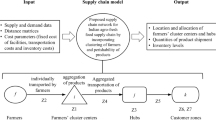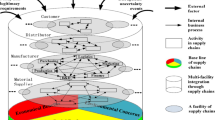Abstract
By increasing world food demand, the agricultural food supply chain has become a key element in the global business competitive environment. Also, the growing population causes increased demand for edible vegetable oils. Edible oil is one of the main products in the home food basket, which shows the importance and attention to the supply chain network of edible vegetable oils. As a result, the present research aims to design a sustainable supply chain network of edible vegetable oils under uncertainty. A mixed-integer linear programming model has developed with three objective functions, including minimizing costs, minimizing environmental impacts, and maximizing social impact. The multi-objective mathematical model has been solved by the preemptive fuzzy goal programming method. In this study, the demand for final edible oil and meals is considered uncertain. A case study has been considered in the supply chain network design of Iranian edible vegetable oils to validate the proposed model. In order to collect the dataset of the input parameters, we considered the three aspects of big data, namely variety, velocity, and volume. Furthermore, some sensitivity analyses have been provided for the main parameters of the present research. The obtained results show that the most important component of the cost objective function is production costs. Furthermore, import tariff and its value have a significant impact on the objective functions and decision variables, including area under cultivation, water consumption, and number of workers. Finally, some suggestions are presented for managers and experts in this industry.






Similar content being viewed by others
Data availability
Enquiries about data availability should be directed to the authors.
References
Agustina D, Lee CKM, Piplani R (2014) Vehicle scheduling and routing at a cross docking center for food supply chains. Int J Prod Econ 2014(152):1–13
Ahumada O, Villalobos JR (2009) Application of planning models in the agri-food supply chain: a review. Eur J Oper Res 196(1):1–20
Alfian G, Syafrudin M, Rhee J (2017) Real-time monitoring system using smartphone-based sensors and NoSQL database for perishable supply chain. Sustainability 9(11):2073
Asadi-Gangraj E, Nayeri S (2018) A hybrid approach based on LP metric method and genetic algorithm for the vehicle-routing problem with time windows, driver-specific times, and vehicles-specific capacities. Int J Oper Res Inf Syst 9(4):51–67
Belaud J-P, Prioux N, Vialle C (2019) Sablayrolles C. Big data for agri-food 4.0: application to sustainability management for by-products supply chain. Comput Ind 111:41–50
Bottani E, Murino T, Schiavo M, Akkerman R (2019) Resilient food supply chain design: modelling framework and metaheuristic solution approach. Comput Ind Eng 135:177–198
Dehghan E, Nikabadi MS, Amiri M, Jabbarzadeh A (2018) Hybrid robust, stochastic and possibilistic programming for closed-loop supply chain network design. Comput Ind Eng 23:220–223
García-Flores R, Higgins A, Prestwidge D, McFallan S (2014) Optimal location of spelling yards for the northern Australian beef supply chain. Comput Electron Agric 102:134–145
Garjan HS, Paydar MM, Divsalar A (2023) A sustainable supply chain for a wellness tourism center considering discount and quality of service. Expert Syst Appl 211:118682
Ghobaei-Arani M, Shahidinejad A (2022) A cost-efficient IoT service placement approach using whale optimization algorithm in fog computing environment. Expert Syst Appl 200:117012
Hosseini-Motlagh S, Samani MRG, Saadi FA (2020) A novel hybrid approach for synchronized development of sustainability and resiliency in the wheat network. Comput Electron Agric 168:105097
Ibrahim HD, Zaidan AA, Qahtan S, Zaidan BB (2023) Sustainability assessment of palm oil industry 4.0 technologies in a circular economy applications based on interval-valued Pythagorean fuzzy rough set-FWZIC and EDAS methods. Appl Soft Comput 136:110073
ICA 2021. Iran customs administration. https://www.irica.ir/index.php?newlang=eng. (Accessed October 2021).
IMIMT 2021. Iran ministry of industry, mine and trade. https://www.mimt.gov.ir/fa/index.php (Accessed October 2021).
IWRMC 2021. Iran water resource management company. http://www.wrm.ir (Accessed September 2021).
Jahangiri A, Asadi-Gangraj E, Nemati A (2022) Designing a reverse logistics network to manage construction and demolition wastes: a robust bi-level approach. J Clean Prod 380:134809
Jazayeri F, Shahidinejad A, Ghobaei-Arani M (2020) Autonomous computation offloading and auto-scaling the in the mobile fog computing: a deep reinforcement learning-based approach. J Ambient Intell Humaniz Comput 12:8265–8284
Jonkman J, Barbosa-Póvoa AP, Bloemhof JM (2019) Integrating harvesting decisions in the design of agro-food supply chains. Eur J Oper Res 276(1):247–258
Jouzdani J, Govindan K (2020) On the sustainable perishable food supply chain network design: a dairy products case to achieve sustainable development goals. J Clean Prod 278:23060
Kamilaris A, Anton A, Blasi AB, Boldú FXP (2018) Assessing and mitigating the impact of livestock agriculture on the environment through geospatial and big data analysis. Int J Sustain Agric Manage Inf 4:98
Kappelman AC, Sinha AK (2021) Optimal control in dynamic food supply chains using big data. Comput Oper Res 126:105117
Kazancoglu Y, Sagnak M, Mangla SK, Sezer MD, Pala MO (2021) A fuzzy based hybrid decision framework to circularity in dairy supply chains through big data solutions. Technol Forecast Soc Chang 170:120927
Kazemi MJ, Paydar MM, Safaei AS (2021) Designing a bi-objective rice supply chain considering environmental impacts under uncertainty. Scientia Iranica. https://doi.org/10.24200/SCI.2021.55935.4481
Kim YK, Kim Y, Kim YJ (2000) Two-sided assembly line balancing: a genetic algorithm approach. Prod Plan Control 11(1):44–53
Kumar A, Mangla SK, Kumar P (2022) An integrated literature review on sustainable food supply chains: exploring research themes and future directions. Sci Total Environ 821:153411
Lamba K, Singh SP (2016) Big Data analytics in supply chain management: some conceptual frameworks. Int J Autom Logist 2(4):279–293
Lamba K, Singh SP, Mishra N (2019) Integrated decisions for supplier selection and lot-sizing considering different carbon emission regulations in big data environment. Comput Ind Eng 128:1052–1062
Li D, Wang X (2017) Dynamic supply chain decisions based on networked sensor data: an application in the chilled food retail chain. Int J Prod Res 55(17):5127–5141
Manouchehri F, Nookabadi AS, Kadivar M (2020) Production routing in perishable and quality degradable supply chains. Heliyon 6(2):03376
MIA 2021. Ministry of Iran Agriculture. https://www.maj.ir/. (Accessed October 2021).
Mogale DG, Dolgui A, Kandhway R, Kumar SK, Tiwari MK (2017) A multi-period inventory transportation model for tactical planning of food grain supply chain. Comput Ind Eng 2017(110):379–394
Mohammed A, Wang Q (2016) The fuzzy multi-objective distribution planner for a green meat supply chain. Int J Prod Econ 184:47–58
Mohebalizadehgashti F, Zolfagharinia H, Amin SH (2019) Designing a green meat supply chain network: a multi-objective approach. Int J Prod Econ 219:312–327
Mosallanezhad M-K, M. Triki C. (2021) Shrimp closed-loop supply chain network design. Soft Comput 25:7399–7422
Motevalli-Taher F, Paydar MM, Emami S (2020) Wheat sustainable supply chain network design with forecasted demand by simulation. Comput Electron Agric 178:105763
Narasimhan R (1980) Goal programming in a fuzzy environment. Decision Sci 11:325–336
Nayeri S, Paydar MM, Asadi-Gangraj E, Emami S (2020) Multi-objective fuzzy robust optimization approach to sustainable closed-loop supply chain network design. Comput Ind Eng 148:106716
Paksoy T, Yapici N, Özceylan E, Pehlivan NY, Özceylan E (2011) Application of fuzzy optimization to a supply chain network design: a case study of an edible vegetable oils manufacturer. Appl Math Model 36(6):2762–2776
Prajapati D, Zhou F, Dwivedi A, Singh T, Lakshay L, Pratap S (2022) Sustainable agro-food supply chain in E-commerce: towards the circular economy. Sustainability 14:8698
Rejeb A, Keogh JG, Rejeb K (2022) Big data in the food supply chain: a literature review. J Data, Inf Manage 4:33–47
Rohmer SUK, Gerdessen JC, Claassen GDH (2018) Sustainable supply chain design in the food system with dietary considerations: a multi-objective analysis. Eur J Oper Res 273(3):1149–1164
Sel C, Bilgen B, Bloemhof-Ruwaard JM, Van der Vorst JGAJ (2015) Multi-bucket optimization for integrated planning and scheduling in the perishable dairy supply chain. Comput Chem Eng 77:59–73
Singh A, Shukla N, Mishra N (2018) Social media data analytics to improve supply chain management in food industries. Trans Res Part E: Logis Trans Rev 114:398–415
Teimoury E, Nedaei H, Ansari S, Sabbaghi M (2013) A multi-objective analysis for import quota policy making in a perishable fruit and vegetable supply chain : a system dynamics approach. Comput Chem Eng 93:37–45
Tomasiello S, Alijani Z (2021) Fuzzy-based approaches for agri-food supply chains: a smini-review. Soft Comput 25:7479–7492
Tsai K, You S, Lin Y (2008) A fuzzy goal programming approach with priority for channel allocation problem in steel industry. Expert Syst Appl 34:1870–1876
Validi S, Bhattacharya A, Byrne PJ (2014) A case analysis of a sustainable food supply chain distribution system—A multi-objective approach. Int J Prod Econ 152:71–87
Van Hop N (2007) Solving fuzzy (stochastic) linear programming problems using superiority and inferiority measures. Inf Sci 177(9):1977–1991
Funding
The authors have not disclosed any funding.
Author information
Authors and Affiliations
Corresponding author
Ethics declarations
Conflict of interest
The authors declare that they have no conflict of interest.
Human participants
This article does not contain any studies with human participants or animals performed by any of the authors.
Informed consent
Informed consent was obtained from all individual participants included in the study.
Additional information
Publisher's Note
Springer Nature remains neutral with regard to jurisdictional claims in published maps and institutional affiliations.
Rights and permissions
Springer Nature or its licensor (e.g. a society or other partner) holds exclusive rights to this article under a publishing agreement with the author(s) or other rightsholder(s); author self-archiving of the accepted manuscript version of this article is solely governed by the terms of such publishing agreement and applicable law.
About this article
Cite this article
Kohansal, F., Asadi-Gangraj, E. & Paydar, M.M. Sustainable edible vegetable oils supply chain network design considering big data: a fuzzy stochastic approach. Soft Comput 27, 15769–15792 (2023). https://doi.org/10.1007/s00500-023-08815-4
Accepted:
Published:
Issue Date:
DOI: https://doi.org/10.1007/s00500-023-08815-4




